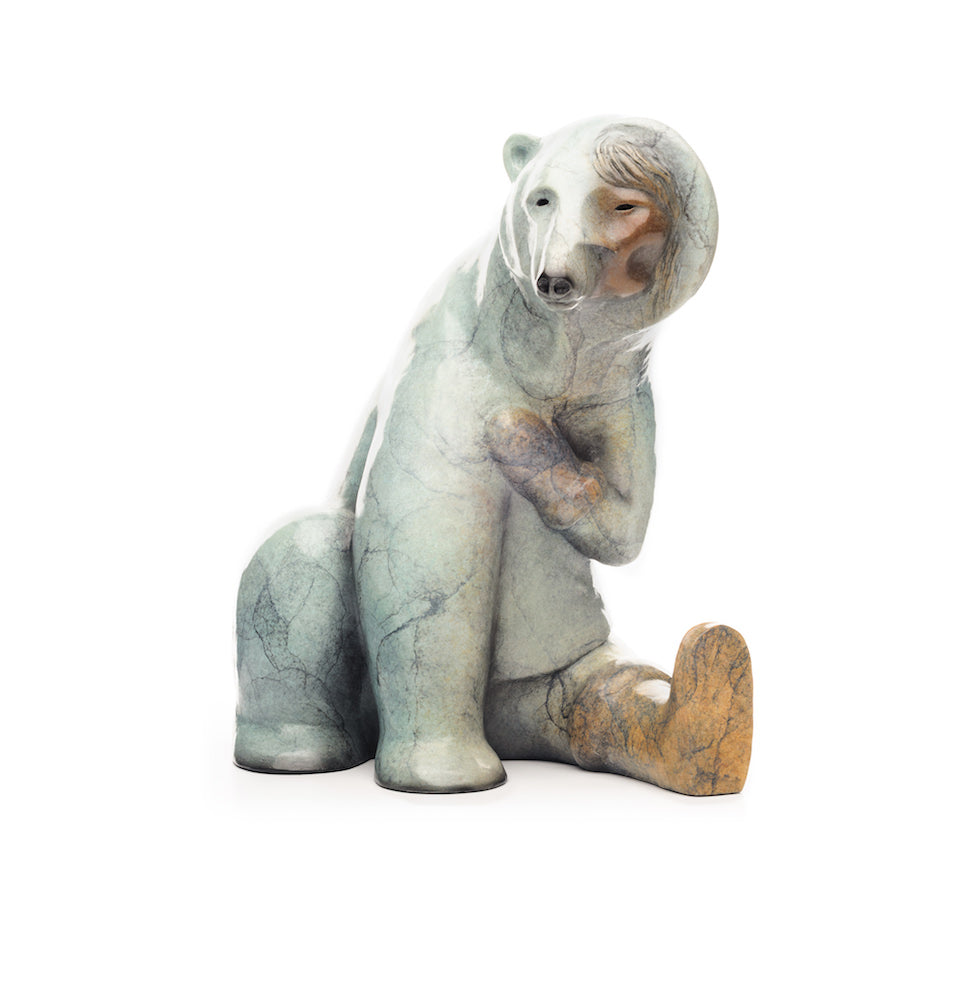Terresa White, Award Winning Yu'pik Sculptor

Award Winning Yup’ik Eskimo Artist Visiting Sisters for Weekend Show
A bronze work offers a polar bear on the right side, a Yup’ik Eskimo woman on the left, merging together at the heartline; a ceramic mask depicts a squinting Yup’ik elder’s face, wrapped in a parka ruff that is a male salmon; another bronze—a man, in traditional Yup’ik dress, dramatically performs an ancient dance and transforms into a walrus mid-sway. These images are both powerful and ethereal in announcing the Yup’ik Peoples world, consciousness, and metaphysical connections. In order to create the works, Terresa White must flow into the mystical realms of her grandmother, her grandmother’s grandmother, and their handed down oral stories of the subarctic world. Imbued with this ancestral awareness, she shares these perspectives about the distant lands in contemporary art forms.
The lands of the Yup’ik Eskimos spread across the Western Central Alaska Region—the Lower Yukon River and Delta, the Lower Kuskokwim River and Delta, and Bristol Bay. Native People of Alaska are referred to as Alaska Natives, rather than Native Americans; the Federal government made the decision for the Alaska Natives Peoples that they would have corporations and private lands, rather than allowing a traditional tribal government and setting aside reservations. Therefore, officially speaking, members are part of a ‘corporation’ rather then a tribe.
Forced displacement of individuals conjures up images of subjugated peoples in places like the Soviet Union during the Collectivization the 1930’s or India in the late 1940’s during the Great Partition. Yet, it also happened in the U.S. Territory of Alaska. Before it became a state in 1959, government officials and missionaries were particularly culpable regarding the removal of Alaska Natives from their homelands for a sundry of reasons. Terresa’s grandmother Clara and great aunts were forcibly taken from their home in remote Alaska for the purpose of educating them in Western World schooling so as to ‘civilize them.’ They represent an example of the dictum espoused by Capt. Henry Pratt. Founder of the infamous Carlisle Indian School of Pennsylvania, he stated in a 1892 speech that our nation needed to “Kill the Indian and Save the Man.”
Granny Clara had a daughter who would become Terresa’s mother and then married a man of German descent in Fairbanks, Alaska. The new formed family resettled in Oregon. Clara’s sisters followed. Having retained their fluency in the Yup’ik language, the women created a community within a community and taught their children the Yup’ik perspectives, culture, and values, while never identifying that the family’s norms, organization, and virtues were derived from a completely different environment and culture.
Terresa grew up in Rainer, Oregon, 2000 miles away and a full generation removed from her family’s Alaska homelands. She is an enrolled member of the Yup’ik People’s Calista Corporation; her traditional tattoos—three lines from the lower lip to chin— proclaim her resolve to be seen as a Yup’ik Eskimo. Terresa’s account of her identity and artistic beginnings coming together follows:
I experienced Eskimo dancing for the first time in a field in rural Oregon with my Granny, Aunties, Mom, and Cousin. We’d been invited by an acquaintance from the Northwest Inupiaq Dancers to attend their gathering. The drums, songs, and dances lit a circle in the grass around our gathering. They cleared a path to my heart’s home! We danced the closing song with the group—iit was my first time dancing, and my thousandth time, I knew it by heart and found myself dancing with my eyes lowered and my vision soaring. I left the gathering inspired to dance and compelled to create.
For years my hands had been itching to make and they saw a path in the traditional, carved wood masks worn by the dancers that day in the field. I joined the dance group after that, found my way to other Alaska Native friends in the Portland and Seattle areas, and soon sculpted my first mask from clay. It was a self-portrait mask, white-faced and wrinkle-eyed, its berry-stained mouth grinning wide.
The transformation masks that followed were born of Yup’ik and other Eskimo stories. They express my understanding of the personhood and interrelationship of all human and non-human beings. Walrus Dance Transformation, my first bronze sculpture, had its inspiration in the powerful masked Walrus Dance I saw performed that day in rural Oregon.
I’ve found that, just like dancing and drumming, telling stories through sculpture comes naturally to me, something outside my intellect, from the experiences of my ancestors before me. I sculpt from my blood and my dreams and the stories shared by Granny Clara through her small Alaska Native storybooks. Art making is healing medicine for me as it transforms suffering, confusion, and loss resulting from displacement into connection and opportunity.
Terresa will be offering an in person show in Sisters September 7 - 9, with an Artist Reception on Friday from 4 to 7 pm. All events will take place at Raven Makes Gallery. Visit Terresa's site for more information on this unique artist.